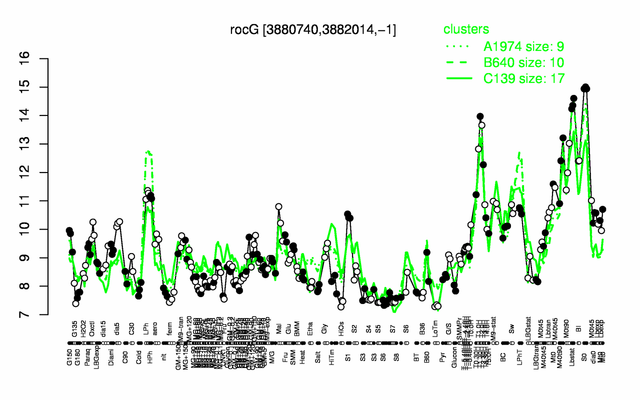RocG
- Description: trigger enzyme: catabolic glutamate dehydrogenase induced by arginine, ornithine or proline, subject to carbon catabolite repression
| Gene name | rocG |
| Synonyms | |
| Essential | no |
| Product | trigger enzyme: glutamate dehydrogenase (major) |
| Function | arginine utilization, controls the activity of GltC |
| Interactions involving this protein in SubtInteract: RocG | |
| Metabolic function and regulation of this protein in SubtiPathways: Ammonium/ glutamate | |
| MW, pI | 46.2 kDa, 6.28 |
| Gene length, protein length | 1272 bp, 424 amino acids |
| Immediate neighbours | rocA, yweA |
| Get the DNA and protein sequences (Barbe et al., 2009) | |
Genetic context 
This image was kindly provided by SubtiList
| |
Expression at a glance PubMed
| |
Contents
Categories containing this gene/protein
utilization of amino acids, glutamate metabolism, transcription factors and their control, trigger enzyme
This gene is a member of the following regulons
AbrB regulon, AhrC regulon, CcpA regulon, RocR regulon, SigL regulon
The gene
Basic information
- Locus tag: BSU37790
Phenotypes of a mutant
- Poor growth on complex media such as SP (sporulation medium). No growth in minimal media with arginine as the only carbon source. Rapid accumulation of suppressor mutants (gudB1)
- sensitive to ß-lactam antibiotics such as cefuroxime and to fosfomycin (suppressed by activation of gudB) due to the downregulation of the SigW regulon PubMed
- transcription profile of a rocG gudB mutant strain: GEO PubMed
Database entries
- DBTBS entry: [1]
- SubtiList entry: [2]
Additional information
The protein
Basic information/ Evolution
- Catalyzed reaction/ biological activity: L-glutamate + H2O + NAD+ = 2-oxoglutarate + NH3 + NADH + H+ (according to Swiss-Prot), controls the activity of the GltC transcription activator PubMed
- Protein family: Glu/Leu/Phe/Val dehydrogenases family (according to Swiss-Prot)
- Paralogous protein(s): GudB
Extended information on the protein
- Kinetic information: KM [glutamate] = 2.9 mM, KM [ammonium] = 18 mM PubMed
- Domains:
- Modification:
- Cofactor(s): NAD+/NADH + H+
- Effectors of protein activity:
Database entries
- Structure: 3K92 (super-repressor mutant that is capable of constitutive inactivation of GltC, E93K mutation) PubMed
- UniProt: P39633
- KEGG entry: [4]
- E.C. number: 1.4.1.2
Additional information
Expression and regulation
- Operon: rocG PubMed
- Regulation:
- Regulatory mechanism:
- Additional information:
Activation by RocR requires binding of RocR to a downstream element PubMed
Biological materials
- Mutant: GP747 (spc), GP726 (aphA3), GP810 (del tet), GP1157 (cat) all available in Stülke lab
- Expression vector:
- expression of native rocG in B. subtilis: pGP529 (in pBQ200), available in Stülke lab
- for purification of RocG from E. coli carrying an N-terminal Strep-tag: pGP902 (in pGP172), a series of rocG variants is also available in pGP172, available in Stülke lab
- for expression/ purification from E. coli with N-terminal His-tag and thrombin cleavage site, in pWH844: pGP860, available in Stülke lab
- purification from B. subtilis with an N-terminal Strep-tag, for SPINE, (in pGP380): pGP1709, available in Stülke lab
- lacZ fusion:
- GFP fusion:
- two-hybrid system: B. pertussis adenylate cyclase-based bacterial two hybrid system (BACTH), available in Stülke lab
- Antibody: available in Stülke lab
Labs working on this gene/protein
Linc Sonenshein, Tufts University, Boston, MA, USA Homepage
Jörg Stülke, University of Göttingen, Germany Homepage
Fabian Commichau University of Göttingen, Germany Homepage
Your additional remarks
References
Reviews
Gunka K, Commichau FM Control of glutamate homeostasis in Bacillus subtilis: a complex interplay between ammonium assimilation, glutamate biosynthesis and degradation. Mol Microbiol.: 2012, 85(2) 213-224. PubMed:22625175
Enzymatic activity of RocG
Function in the control of GltC activity
Katrin Gunka, Joseph A Newman, Fabian M Commichau, Christina Herzberg, Cecilia Rodrigues, Lorraine Hewitt, Richard J Lewis, Jörg Stülke
Functional dissection of a trigger enzyme: mutations of the bacillus subtilis glutamate dehydrogenase RocG that affect differentially its catalytic activity and regulatory properties.
J Mol Biol: 2010, 400(4);815-27
[PubMed:20630473]
[WorldCat.org]
[DOI]
(I p)
Christina Herzberg, Lope Andrés Flórez Weidinger, Bastian Dörrbecker, Sebastian Hübner, Jörg Stülke, Fabian M Commichau
SPINE: a method for the rapid detection and analysis of protein-protein interactions in vivo.
Proteomics: 2007, 7(22);4032-5
[PubMed:17994626]
[WorldCat.org]
[DOI]
(P p)
Fabian M Commichau, Christina Herzberg, Philipp Tripal, Oliver Valerius, Jörg Stülke
A regulatory protein-protein interaction governs glutamate biosynthesis in Bacillus subtilis: the glutamate dehydrogenase RocG moonlights in controlling the transcription factor GltC.
Mol Microbiol: 2007, 65(3);642-54
[PubMed:17608797]
[WorldCat.org]
[DOI]
(P p)
Fabian M Commichau, Ingrid Wacker, Jan Schleider, Hans-Matti Blencke, Irene Reif, Philipp Tripal, Jörg Stülke
Characterization of Bacillus subtilis mutants with carbon source-independent glutamate biosynthesis.
J Mol Microbiol Biotechnol: 2007, 12(1-2);106-13
[PubMed:17183217]
[WorldCat.org]
[DOI]
(P p)
Boris R Belitsky, Abraham L Sonenshein
Modulation of activity of Bacillus subtilis regulatory proteins GltC and TnrA by glutamate dehydrogenase.
J Bacteriol: 2004, 186(11);3399-407
[PubMed:15150225]
[WorldCat.org]
[DOI]
(P p)
Expression of rocG
Additional publications: PubMed
Structural analysis of glutamate dehydrogenase
Bypass of rocG mutations
Katrin Gunka, Stefan Tholen, Jan Gerwig, Christina Herzberg, Jörg Stülke, Fabian M Commichau
A high-frequency mutation in Bacillus subtilis: requirements for the decryptification of the gudB glutamate dehydrogenase gene.
J Bacteriol: 2012, 194(5);1036-44
[PubMed:22178973]
[WorldCat.org]
[DOI]
(I p)
Lope A Flórez, Katrin Gunka, Rafael Polanía, Stefan Tholen, Jörg Stülke
SPABBATS: A pathway-discovery method based on Boolean satisfiability that facilitates the characterization of suppressor mutants.
BMC Syst Biol: 2011, 5;5
[PubMed:21219666]
[WorldCat.org]
[DOI]
(I e)